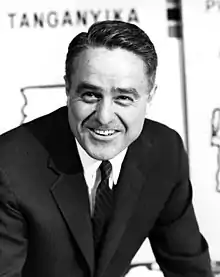1972 Democratic Party vice presidential candidate selection
This article lists those who were potential candidates for the Democratic nomination for Vice President of the United States in the 1972 election. Coming into the 1972 Democratic National Convention, South Dakota Senator George McGovern had the delegate lead, but did not have the presidential nomination locked up.[1] After winning the Democratic nomination for president on July 13, McGovern looked for a running mate.[2] McGovern's first choice for vice president was Ted Kennedy, but Kennedy refused to join the ticket; Minnesota Senator Walter Mondale,[2] Wisconsin Senator Gaylord Nelson, and Connecticut Senator Abraham A. Ribicoff also declined.[1] McGovern offered the position to Missouri Senator Thomas Eagleton, who appealed to labor groups and Catholics, two groups that McGovern had alienated during the primary campaign.[1] The ticket of McGovern and Eagleton was nominated by the 1972 Democratic National Convention. Following the convention, it was revealed that in the 1960s, Eagleton had received treatment for depression.[1] Though McGovern considered keeping Eagleton on the ticket, he ultimately chose to replace Eagleton with former Ambassador Sargent Shriver.[3] The McGovern-Shriver ticket lost the presidential election to the Nixon-Agnew ticket. After the controversy surrounding Eagleton, future campaigns spent much more time vetting vice presidential candidates.[2]

Potential running mates
- Missouri Senator Thomas Eagleton (later withdrew)
- Former Ambassador Sargent Shriver
- Alaska Senator Mike Gravel[4]
- Boston Mayor Kevin White[2]
- Connecticut Senator Abraham A. Ribicoff[1]
- Florida Governor Reubin Askew[5]
- Idaho Senator Frank Church[5]
- Former Massachusetts Governor Endicott Peabody[4]
- Massachusetts Senator Ted Kennedy[4]
- Minnesota Senator Walter Mondale[2]
- New Jersey Representative Peter Rodino[4]
- Former Postmaster General Larry O'Brien[6]
- Wisconsin Governor Patrick Lucey[6]
- Wisconsin Senator Gaylord Nelson[1]
Frances Farenthold’s candidacy
At the 1972 Democratic National Convention, there came a grassroots effort to nominate Texas State Representative and unsuccessful candidate for the Democratic nomination for Governor of Texas, Frances Farenthold. She had gained recognition due to her surprising, though unsuccessful, forced run-off against Texas’ incumbent Democratic Governor Dolph Briscoe in the Democratic primaries.[7]
The effort to nominate her for Vice President came after the realization that Shirley Chisholm, the first major black candidate for President of the United States, would not have the delegates necessary to win the nomination at the convention. Chisholm had had the endorsement of and had helped found the National Women’s Political Caucus, a new organization formed in Washington, D.C. in 1971.[8] Following her convention defeat, the caucus had moved to recruit Farenthold to run for the Vice Presidency. The individual chosen to place Francis “Sissy” Farenthold’s name in nomination for Vice President would be Gloria Steinem, the co-founder of Ms. magazine.[9]
Although the nomination effort aroused the convention-goers mired in malaise and anger from the difficult 1972 Democratic National Convention, the campaign for her Vice Presidency was highly disorganized and last-minute, without a serious chance at denying Senator Thomas Eagleton his nomination by George McGovern. Despite coming from the state of Texas, the Texas delegation, controlled by Dolph Briscoe, did not support her candidacy. Regardless, the balloting for Vice President finished with Farenthold receiving 405 delegates, and 13.73% of the vote, the second-most of all of the candidates.[10]
Farenthold was the first serious female candidate for the nomination for Vice President of the United States, by either major political party. She would go on to once again compete with and lose to Dolph Briscoe for the Democratic nomination for Governor of Texas in 1974.
References
- NPR Staff (August 4, 2012). "The Thomas Eagleton Affair Haunts Candidates Today". NPR. Retrieved October 5, 2015.
- Altman, Lawrence (July 23, 2012). "Hasty and Ruinous 1972 Pick Colors Today's Hunt for a No. 2". New York Times. Retrieved October 5, 2015.
- Thurber, Jon (March 5, 2007). "Thomas Eagleton, 77; vice presidential candidate left race over health reports". LA Times. Retrieved October 5, 2015.
- Rudin, Ken (March 7, 2007). "The Eagleton Fiasco of 1972". NPR. Retrieved October 5, 2015.
- Sigelman, Lee; Wahlbeck, Paul (December 1997). "The "Veepstakes": Strategic Choice in Presidential Running Mate Selection". The American Political Science Review. 91 (4): 858. doi:10.2307/2952169. JSTOR 2952169.
- Baumgartner, Jody (January 1, 2006). The American Vice Presidency Reconsidered. Greenwood Publishing Group. p. 61. ISBN 9780275988906. Retrieved October 5, 2015.
- "Frances Tarlton "Sissy" Farenthold | Vice Presidential Nomination". law.utexas.edu. Retrieved January 25, 2021.
- "History". National Women's Political Caucus. Retrieved January 25, 2021.
- "Frances Tarlton "Sissy" Farenthold | Vice Presidential Nomination". law.utexas.edu. Retrieved January 25, 2021.
- "Our Campaigns - US Vice President - D Convention Race - Jul 10, 1972". www.ourcampaigns.com. Retrieved January 25, 2021.